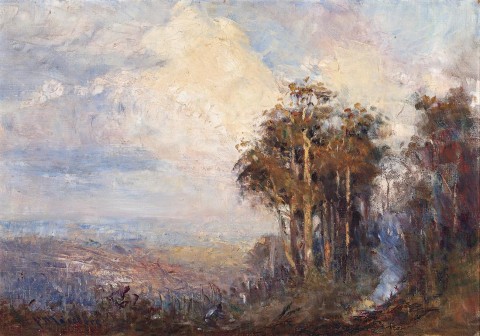VIEW FROM MOUNT MACEDON, c.1907
FREDERICK McCUBBIN
oil on canvas
35.5 x 51.0 cm
signed lower left: F McCubbin
Private collection
Kathie Robb Fine Art, Sydney
Ken and Rona Eastaugh, Melbourne, acquired from the above c.1990
Thence by descent
Private collection, Melbourne
possibly: Exhibition of Pictures by Frederick McCubbin, Guild Hall, Melbourne, 17 – 31 May 1907
When Frederick McCubbin exhibited his triptych The Pioneer in 1905, critics noted that he had repainted part of the right wing ‘in the manner of Turner’.1 A summation of his early works narrating the toils of the pioneer, it was painted with detailed realism and elaborate finish. The reworked part heralded a striking new development. McCubbin had a lifelong interest in the art of the great English painter, J. M. W. Turner, known at first only through illustration and reproduction. While the sale of The Pioneer to the National Gallery of Victoria through the Felton Bequest in 1906 assisted McCubbin to travel to England to see his hero in the original, his paintings prior to this trip of 1907 had come increasingly under the British master’s influence, particularly in their breadth and spontaneity.
McCubbin’s move to Macedon in 1901 played a significant part, numerous landscapes of the following years revealing his response to the vivacity of light, expressed through vibrating touches and dashes of paint. The first Macedon landscapes are more quietly and closely observed, as in A Bush Scene, 1903 (Art Gallery of Ballarat, Victoria). Soon they give way to the broader, treed landscapes of 1904, in turn leading to the panoramas of 1906. A rather grand example is Looking North from Mount Macedon, 1906 (once in the collection of the Commercial Travellers’ Association of Victoria). While 1907 is celebrated as the year in which McCubbin’s painting underwent great change through his visit to England to see his beloved Turner face to face, he produced a number of outstanding landscapes before he went. These include The Road to Braemar, 1907 (Mildura Arts Centre, Victoria) and Wattle Glade, Macedon, 1907 (once in the distinguished collection of Sir Baldwin Spencer). Our painting, View from Mount Macedon, c.1907, has an affinity with The Road to Braemar, sharing tall noble gums, sweep of distant hills and valleys, the broad expanse of sky filled with imposing cumulous clouds. There is also a humanising touch, which McCubbin never quite abandoned in his landscapes. Seen earlier in Campsite Near Narbethong, c.1904 and Looking North from Mount Macedon, 1906, in View from Mount Macedon evening shadows begin to fill the foreground as smoke from the campfire ascends, all capturing the peaceful mood of end of day. The influence of the gifted colonial painter Louis Buvelot was very present in McCubbin’s paintings. ‘I remember as if it were yesterday, [McCubbin wrote in 1916] standing one evening a long time ago, watching the sunset glowing on the trees in Studley Park, and it was largely through Buvelot that I realised the beauty of the scene’.3 In further comment, McCubbin almost describes our painting: ‘The feeling of closing day, approaching night and rest, the billy fire, and the smoke ascending from the burning gum branches, typify so much of life along the Victorian roads’.4 In its assured translation of the influences of Buvelot and Turner, View from Mount Macedon provides a masterly example of McCubbin’s development towards his dazzling final manner.
1. Hoff, U., ‘The Phases of McCubbin’s Art’, Meanjin, Melbourne, vol. 15, no. 3, 1956, p. 304
2. Campsite Near Narbethong, c.1904, oil on canvas, 24.3 x 34.3 cm, sold Sotheby’s, Melbourne, 24 August 2009, lot 41
3. McCubbin, F., ‘Some Remarks on the History of Australian Art’, in MacDonald, J. S., The Art of Frederick McCubbin, Lothian Book Publishing, Melbourne, 1916, p. 85
4. ibid., p. 86
DAVID THOMAS
